-
In TOGAF, Gap Analysis is a critical technique used during the Architecture Development Method (ADM) to identify the differences between the Baseline Architecture (current state) and the Target Architecture (future state). These gaps highlight what needs to change—whether it’s capabilities, systems, processes, or technologies.
Gap Analysis helps organizations:
- Understand what’s missing or needs improvement
- Prioritize initiatives
- Plan transition architectures and roadmaps
🧱 Key Concepts of TOGAF Gap Analysis
- Baseline Architecture
The current state of the enterprise architecture. - Target Architecture
The desired future state aligned with business goals. - Identified Gaps
The differences between the baseline and target states—these could be missing capabilities, outdated systems, or skill shortages. - Transition Architectures
Intermediate states that help bridge the gap in manageable phases.
🖼️ Visual Diagram
Here’s a visual representation of the TOGAF Gap Analysis process:

🌍 Real-World Examples
1. Telecom Provider – 5G Network Rollout
Scenario:
A telecom company is transitioning from 4G to 5G infrastructure.Gap Analysis in Action:
- Baseline Architecture: 4G LTE towers, legacy OSS/BSS systems.
- Target Architecture: 5G NR, edge computing, AI-driven network management.
- Identified Gaps: Lack of edge infrastructure, outdated billing systems.
- Transition Architectures: Hybrid 4G/5G zones, phased OSS upgrades.
Outcome:
Strategic investment planning and phased deployment with minimal service disruption.
2. University – Digital Learning Transformation
Scenario:
A university wants to modernize its learning environment post-pandemic.Gap Analysis in Action:
- Baseline Architecture: On-premise LMS, limited remote access.
- Target Architecture: Cloud-based LMS, integrated video conferencing, mobile access.
- Identified Gaps: No mobile support, poor scalability.
- Transition Architectures: Pilot cloud LMS, integrate video tools, migrate in phases.
Outcome:
Improved student engagement and scalable digital infrastructure.
3. Retail Chain – Unified Customer Experience
Scenario:
A retail chain aims to unify its online and in-store customer experience.Gap Analysis in Action:
- Baseline Architecture: Separate POS and e-commerce systems.
- Target Architecture: Unified CRM, real-time inventory, omnichannel analytics.
- Identified Gaps: Data silos, inconsistent customer profiles.
- Transition Architectures: API integration, centralized data lake.
Outcome:
Enhanced customer satisfaction and operational efficiency.
🧩 Conclusion
Gap Analysis in TOGAF is a powerful tool for identifying what needs to change to achieve strategic goals. By clearly mapping the current and future states, and defining the gaps, organizations can plan effective, phased transformations that deliver measurable value.
-
In TOGAF, Risk Management is a critical component of enterprise architecture governance. It ensures that risks to architecture development and implementation are identified, assessed, and mitigated effectively.
Risk Management in TOGAF is integrated into the Architecture Development Method (ADM) and supports informed decision-making, compliance, and strategic alignment.
🧱 Key Concepts of Risk Management in TOGAF
TOGAF outlines a structured approach to managing risk through the following stages:
- Risk Identification
Recognizing potential threats to architecture initiatives, such as technology failures, compliance issues, or resource constraints. - Risk Assessment
Evaluating the likelihood and impact of identified risks using qualitative or quantitative methods. - Risk Response
Defining strategies to mitigate, transfer, accept, or avoid risks. - Risk Monitoring
Continuously tracking risks and the effectiveness of mitigation strategies. - Governance Integration
Embedding risk management into architecture governance processes to ensure accountability and oversight.
🖼️ Visual Diagram
Here’s a visual representation of the TOGAF Risk Management process:

🌍 Real-World Examples
1. Banking Sector – Core System Upgrade
Scenario:
A bank is upgrading its core banking system, which involves high operational and compliance risks.Risk Management in Action:
- Risk Identification: Legacy system dependencies, data migration errors.
- Risk Assessment: High impact on customer transactions.
- Risk Response: Phased rollout, backup systems.
- Risk Monitoring: Daily risk reviews during migration.
- Governance Integration: Oversight by the Architecture Board.
Outcome:
Successful upgrade with minimal disruption and full regulatory compliance.
2. Healthcare – Electronic Health Record (EHR) Implementation
Scenario:
A hospital network is implementing a new EHR system across multiple facilities.Risk Management in Action:
- Risk Identification: Data privacy, user adoption.
- Risk Assessment: Medium likelihood, high impact.
- Risk Response: Staff training, encryption protocols.
- Risk Monitoring: Weekly audits and feedback loops.
- Governance Integration: Risk reports submitted to the IT governance committee.
Outcome:
Improved patient care and secure data handling with proactive risk mitigation.
3. Retail – Omnichannel Integration
Scenario:
A retail chain is integrating online and in-store systems for a seamless customer experience.Risk Management in Action:
- Risk Identification: System integration failures, inconsistent data.
- Risk Assessment: High likelihood, medium impact.
- Risk Response: API testing, data validation routines.
- Risk Monitoring: Real-time dashboards and alerts.
- Governance Integration: Architecture team reviews risk metrics monthly.
Outcome:
Smooth integration and enhanced customer satisfaction with reduced operational risk.
🧩 Conclusion
Risk Management in TOGAF is not a one-time activity—it’s a continuous, integrated process that supports the success of enterprise architecture initiatives. By embedding risk thinking into every phase of architecture development, organizations can navigate complexity with confidence and resilience.
- Risk Identification
-
In TOGAF, Architecture Capability refers to the organization’s ability to develop, maintain, and govern enterprise architecture effectively. It is not just about tools or frameworks—it’s about people, processes, governance, and maturity.
Architecture Capability ensures that enterprise architecture delivers real business value and aligns with strategic goals.
🧱 Key Components of Architecture Capability
TOGAF defines several core elements that together form the Architecture Capability:
- Architecture Board
A governing body that oversees architecture decisions, compliance, and strategic alignment. - Architecture Compliance
Ensures that projects and solutions conform to the defined architecture standards and principles. - Architecture Contracts
Formal agreements between development partners and architecture teams to ensure alignment. - Architecture Governance
The framework and processes for managing architecture activities and ensuring accountability. - Architecture Maturity
A measure of how well architecture practices are embedded and optimized within the organization. - Architecture Skills Framework
A model for assessing and developing the skills of architecture practitioners.
🖼️ Visual Diagram
Here’s a visual representation of the TOGAF Architecture Capability and its components:
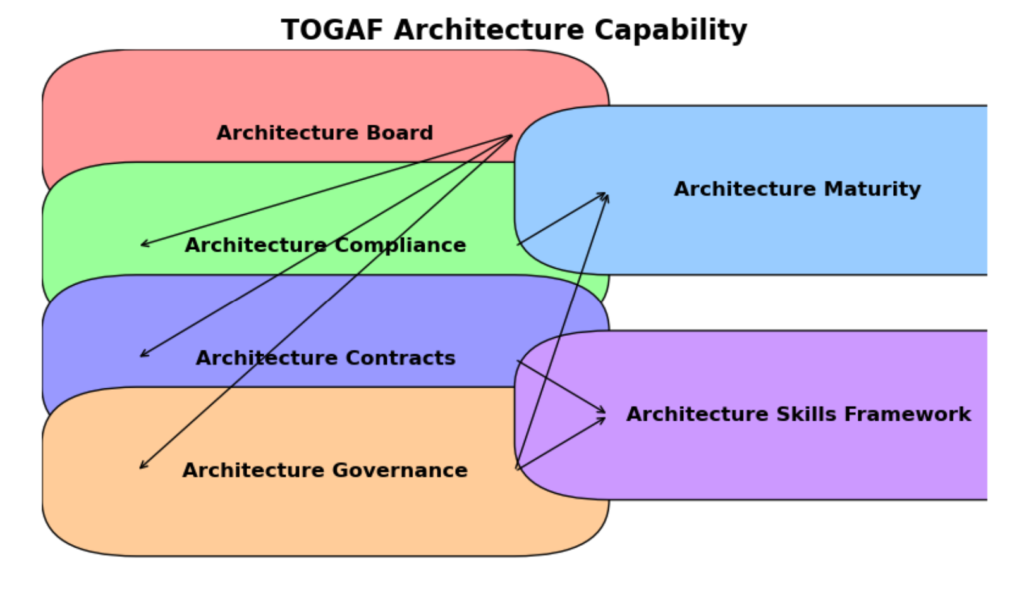
🌍 Real-World Examples
1. Insurance Company – Regulatory Compliance
Scenario:
An insurance firm must comply with new data protection regulations across multiple regions.Architecture Capability in Action:
- Architecture Board defines compliance strategy.
- Architecture Compliance ensures all systems meet regulatory standards.
- Architecture Contracts formalize responsibilities with vendors.
Outcome:
Faster compliance with reduced risk and improved audit readiness.
2. Retail Enterprise – Cloud Migration
Scenario:
A global retailer is migrating its legacy systems to the cloud.Architecture Capability in Action:
- Architecture Governance ensures consistent cloud adoption practices.
- Architecture Maturity assessment identifies gaps in cloud readiness.
- Architecture Skills Framework guides upskilling of IT teams.
Outcome:
Smooth migration with minimal disruption and improved agility.
3. Government Agency – Smart Infrastructure
Scenario:
A city government is implementing smart infrastructure for traffic and utilities.Architecture Capability in Action:
- Architecture Board aligns initiatives with city strategy.
- Architecture Contracts manage collaboration with tech vendors.
- Architecture Compliance ensures interoperability and security.
Outcome:
Efficient rollout of smart services with strong governance and public trust.
🧩 Conclusion
Architecture Capability is the foundation of successful enterprise architecture. By investing in governance, skills, and maturity, organizations can ensure that architecture is not just a theoretical exercise—but a strategic enabler of transformation.
- Architecture Board
-
The TOGAF® Content Framework and Enterprise Metamodel
- Posted on: June 2, 2025
- by: Anand Pandey
- 0 Comments
The TOGAF® Content Framework provides a structured model for developing, managing, and communicating enterprise architecture artifacts. At its core lies the Enterprise Metamodel, which defines the types of architectural building blocks and their relationships.
Together, they ensure consistency, traceability, and reusability across architecture domains—Business, Application, Data, and Technology.
🧱 Key Concepts
🔹 TOGAF Content Framework
- A taxonomy and structure for organizing architecture artifacts.
- Supports the Architecture Development Method (ADM).
- Defines core content types such as:
- Principles
- Requirements
- Business Services
- Applications
- Data Entities
- Technology Components
🔹 Enterprise Metamodel
- A formal model that defines:
- Artifact types
- Relationships
- Attributes
- Enables tool interoperability and automated governance.
🖼️ Visual Diagram
Here’s a visual representation of the TOGAF Content Framework and Enterprise Metamodel:
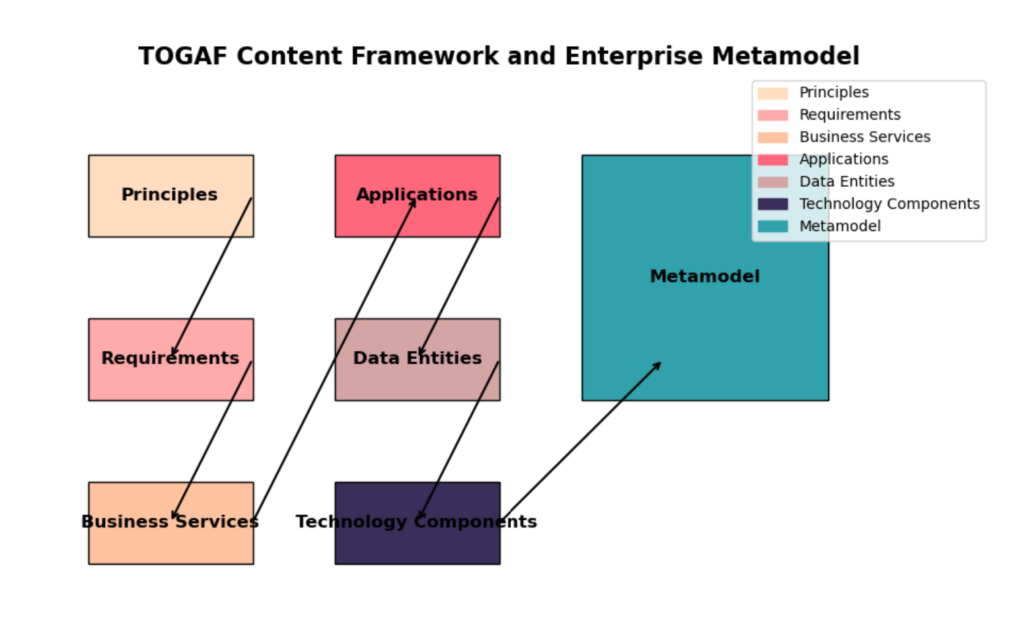
🌍 Real-World Examples
1. Healthcare Provider – Integrated Patient Care
Scenario:
A national healthcare provider aims to integrate patient records across hospitals, clinics, and labs.Use of Content Framework:
- Principles: Data privacy and interoperability.
- Requirements: Unified patient ID, real-time access.
- Business Services: Patient registration, diagnostics.
- Applications: EHR systems, lab management.
- Data Entities: Patient records, lab results.
- Technology Components: Cloud storage, secure APIs.
Outcome:
Improved patient outcomes and operational efficiency through a unified architecture.
2. Telecom Company – 5G Rollout
Scenario:
A telecom company is rolling out 5G infrastructure and services.Use of Content Framework:
- Principles: Scalability, low latency.
- Requirements: Edge computing, network slicing.
- Business Services: Mobile broadband, IoT connectivity.
- Applications: Network orchestration tools.
- Data Entities: Subscriber profiles, usage data.
- Technology Components: 5G towers, edge servers.
Outcome:
Faster deployment and better alignment between business goals and technical execution.
3. Retail Chain – Digital Customer Experience
Scenario:
A retail chain wants to enhance its omnichannel customer experience.Use of Content Framework:
- Principles: Customer-centricity, agility.
- Requirements: Real-time inventory, personalized offers.
- Business Services: Order fulfillment, loyalty programs.
- Applications: CRM, e-commerce platform.
- Data Entities: Customer profiles, product catalog.
- Technology Components: POS systems, cloud analytics.
Outcome:
Increased customer satisfaction and sales through a consistent digital experience.
🧩 Conclusion
The TOGAF Content Framework and Enterprise Metamodel are essential tools for structuring and governing enterprise architecture. By clearly defining content types and their relationships, organizations can ensure alignment, traceability, and agility in their transformation journeys.
-
In TOGAF, the Architecture Repository is a structured storage area that houses all architectural output and reference materials used throughout the enterprise architecture lifecycle. It supports the Architecture Development Method (ADM) by providing a central location for storing:
- Models
- Patterns
- Standards
- Governance logs
- Capability assessments
This repository ensures consistency, reusability, and traceability across architecture initiatives.
🧱 Core Components of the Architecture Repository
Here’s a breakdown of the six key components:
- Architecture Metamodel
Defines the structure, semantics, and relationships of architecture artifacts. - Architecture Landscape
Represents the current, transitional, and target states of the enterprise architecture. - Standards Information Base (SIB)
A collection of standards and guidelines that govern architecture development. - Reference Library
Contains best practices, templates, and reusable architecture artifacts. - Governance Log
Records decisions, compliance assessments, and audit trails. - Architecture Capability
Describes the organization’s ability to develop and sustain enterprise architecture.
🖼️ Visual Diagram
Here’s a visual representation of the Architecture Repository and its components:
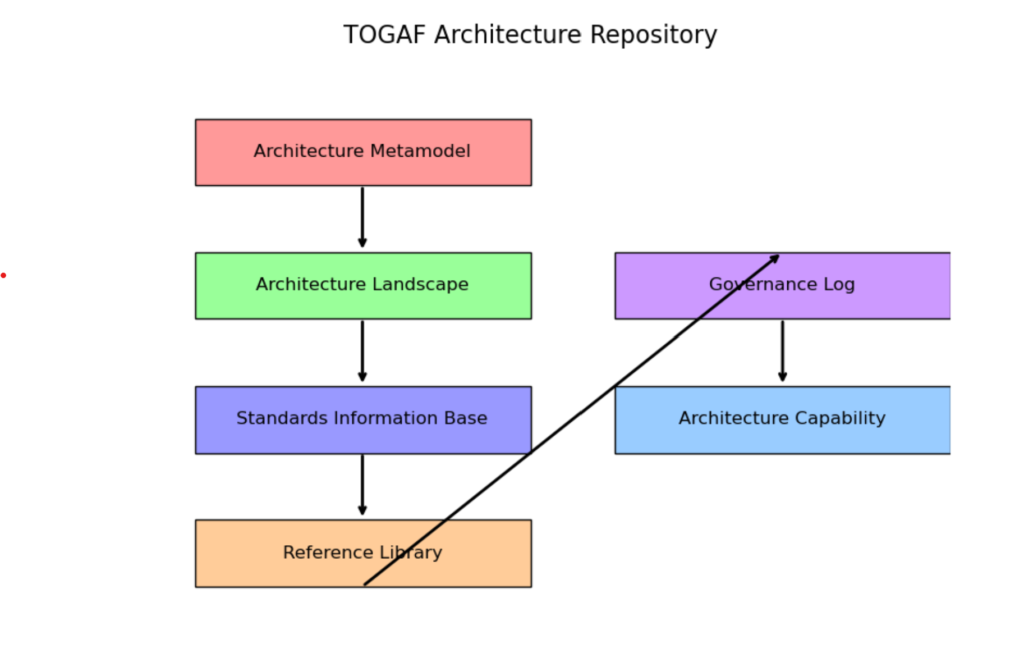
🌍 Real-World Examples
1. Global Bank – Digital Transformation
Scenario:
A multinational bank is undergoing a digital transformation to modernize its legacy systems and improve customer experience.Use of Architecture Repository:
- Architecture Landscape maps current legacy systems and target cloud-native platforms.
- Standards Information Base ensures compliance with financial regulations like PCI-DSS.
- Reference Library provides reusable microservices patterns for customer onboarding.
Outcome:
Accelerated transformation with reduced duplication and improved regulatory compliance.
2. Government Agency – Smart City Initiative
Scenario:
A city government launches a smart city initiative integrating IoT, traffic systems, and citizen services.Use of Architecture Repository:
- Architecture Metamodel defines relationships between IoT devices, data flows, and services.
- Governance Log tracks decisions on data privacy and vendor selection.
- Architecture Capability assesses internal readiness and identifies skill gaps.
Outcome:
Improved coordination across departments and vendors, ensuring a scalable and secure smart city architecture.
3. Retail Chain – Omnichannel Strategy
Scenario:
A retail chain aims to unify its online and in-store customer experience.Use of Architecture Repository:
- Architecture Landscape visualizes integration points between POS systems and e-commerce platforms.
- Reference Library includes reusable APIs for inventory and customer data.
- Governance Log documents decisions on third-party integrations and data sharing policies.
Outcome:
Seamless customer experience and faster rollout of new digital services.
🧩 Conclusion
The Architecture Repository is not just a storage system—it’s the backbone of enterprise architecture governance and execution. By organizing and centralizing architectural assets, organizations can drive consistency, agility, and strategic alignment across initiatives.
-
In enterprise architecture, one size rarely fits all. Organizations need a way to adapt architectural assets to their unique needs while still leveraging industry standards and best practices. TOGAF addresses this challenge through the concept of the Enterprise Continuum—a powerful model for organizing and evolving architectural assets.
🧱 What is the Enterprise Continuum?
The Enterprise Continuum is a classification mechanism in TOGAF that helps architects understand and manage the evolution of architecture assets. It spans from generic, foundational architectures to highly specific, organization-tailored solutions.
It consists of two key parts:
- Architecture Continuum: Describes the progression of architectural models from abstract to concrete.
- Solutions Continuum: Describes the implementation of those models in real-world solutions.
🧩 Visualizing the Enterprise Continuum
Here’s a diagram that illustrates the structure of the Enterprise Continuum:
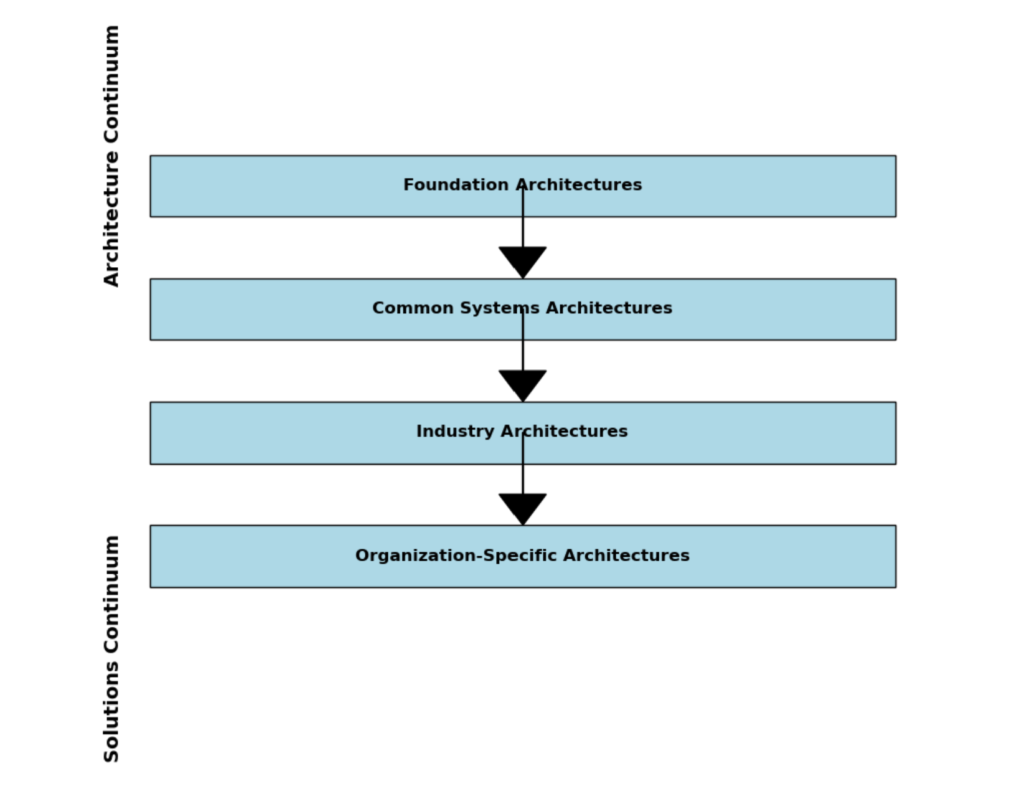
This diagram shows how architecture evolves from Foundation Architectures to Organization-Specific Architectures, with the Architecture Continuum guiding the design and the Solutions Continuum guiding implementation.
🔍 Key Layers of the Continuum
1. Foundation Architectures
- Generic building blocks and standards (e.g., TCP/IP, identity management).
- Often provided by vendors or open standards bodies.
2. Common Systems Architectures
- Reusable services and platforms (e.g., enterprise service bus, cloud platforms).
- Provide solutions to common problems across industries.
3. Industry Architectures
- Tailored to specific sectors (e.g., banking, healthcare, manufacturing).
- Include regulatory compliance, industry-specific data models, etc.
4. Organization-Specific Architectures
- Customized to meet the unique needs of a specific enterprise.
- Includes internal processes, proprietary systems, and strategic goals.
✅ Real-World Example 1: Global Retail Chain
Foundation Architecture
- Uses standard cloud infrastructure (e.g., AWS, Azure).
- Implements global identity and access management.
Common Systems Architecture
- Deploys a shared e-commerce platform across regions.
- Integrates with payment gateways and logistics APIs.
Industry Architecture
- Adopts retail-specific data models (e.g., product catalogs, inventory).
- Complies with PCI-DSS for payment security.
Organization-Specific Architecture
- Custom loyalty program, regional pricing engines, and in-store kiosk systems.
✅ Real-World Example 2: National Healthcare Network
Foundation Architecture
- Uses open standards like HL7 and FHIR for health data exchange.
Common Systems Architecture
- Implements a national patient ID system and secure messaging.
Industry Architecture
- Aligns with healthcare regulations (e.g., HIPAA, GDPR).
- Includes templates for EHR systems and telemedicine platforms.
Organization-Specific Architecture
- Custom workflows for hospitals, clinics, and insurance providers.
- Integrated mobile apps for patients and doctors.
✅ Real-World Example 3: Government Digital Services
Foundation Architecture
- Leverages open-source platforms and national cloud infrastructure.
Common Systems Architecture
- Shared authentication and citizen identity services.
Industry Architecture
- Public sector frameworks for digital governance and service delivery.
Organization-Specific Architecture
- Custom portals for tax, licensing, and public records.
📝 Summary
The Enterprise Continuum in TOGAF provides a structured way to evolve and classify architectural assets—from foundational standards to organization-specific solutions. It empowers enterprises to reuse proven models, adapt to industry needs, and build architectures that are both robust and flexible. Whether you’re in retail, healthcare, or government, the Enterprise Continuum helps you bridge the gap between theory and implementation.
-
Architecture Abstraction in Enterprise Architecture
- Posted on: June 2, 2025
- by: Anand Pandey
- 0 Comments
In the world of enterprise architecture, managing complexity is a constant challenge. TOGAF (The Open Group Architecture Framework) addresses this by introducing the concept of architecture abstraction—a structured way to view systems at different levels of detail. This approach helps stakeholders—from executives to developers—understand and contribute to the architecture in ways that are meaningful to them.
🧱 What is Architecture Abstraction in TOGAF?
TOGAF promotes the use of three levels of abstraction to describe architecture:
- Conceptual Architecture: High-level view of business goals, capabilities, and stakeholder needs.
- Logical Architecture: Technology-agnostic design of systems, data flows, and application interactions.
- Physical Architecture: Concrete implementation details including platforms, tools, and infrastructure.
Each level builds upon the previous one, ensuring that strategic intent is preserved all the way through to implementation.
🧩 Visualizing Architecture Abstraction
Here’s a clear, high-resolution diagram that illustrates how abstraction levels align with the four architecture domains:
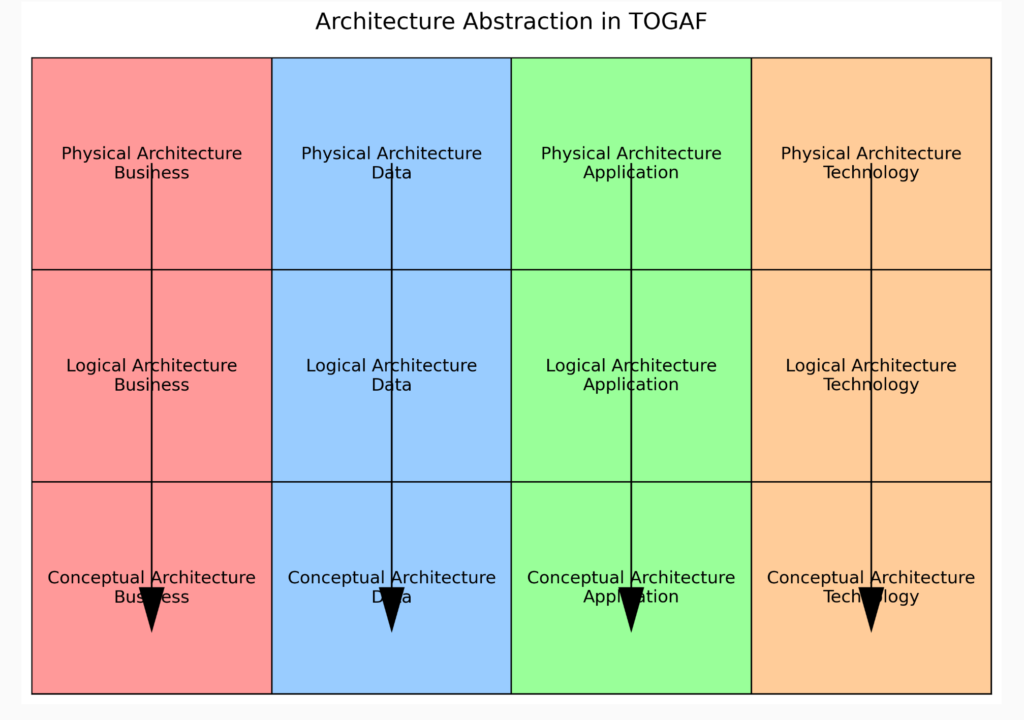
This diagram shows how each abstraction layer—Conceptual, Logical, and Physical—spans across the Business, Data, Application, and Technology domains, creating a cohesive and scalable architecture.
✅ Real-World Example 1: Smart City Traffic Management System
🔹 Conceptual Architecture
- Goal: Reduce traffic congestion and improve commuter experience.
- Capabilities: Real-time traffic monitoring, dynamic signal control, commuter alerts.
🔹 Logical Architecture
- Components: Traffic data aggregator, analytics engine, mobile app interface.
- Data Flow: Sensor data → Analytics → Dashboard & Alerts.
🔹 Physical Architecture
- Technologies: IoT sensors, cloud-based analytics (e.g., AWS Lambda), mobile app (iOS/Android), 5G connectivity.
✅ Real-World Example 2: National Digital Health Platform
🔹 Conceptual Architecture
- Goal: Improve healthcare access and patient outcomes.
- Capabilities: Patient records, telemedicine, prescription management.
🔹 Logical Architecture
- Components: EHR system, video consultation module, pharmacy integration.
- Data Flow: Patient data → Doctor interface → Prescription system.
🔹 Physical Architecture
- Technologies: Cloud-hosted EHR (e.g., Azure), secure video conferencing (e.g., WebRTC), encrypted APIs for pharmacies.
🏷 Suggested Tags
- TOGAF
- Enterprise Architecture
- Architecture Abstraction
- Conceptual Architecture
- Logical Architecture
- Physical Architecture
- Smart City
- Digital Health
- IT Strategy
- Architecture Framework
📝 Summary
Architecture abstraction in TOGAF is a foundational concept that enables clarity, collaboration, and scalability. By separating architecture into conceptual, logical, and physical layers, organizations can ensure that strategic intent is preserved from vision to implementation. Whether you’re building a smart city or a national health platform, abstraction is the key to managing complexity and delivering value.
-
TOGAF (The Open Group Architecture Framework) organizes enterprise architecture into four interrelated domains. These domains provide a structured way to analyze, design, and implement systems that align with business goals.
🔍 The Four Architecture Domains (Explained in Detail)
1. Business Architecture
This domain defines:
- The organizational structure
- Business processes
- Capabilities, functions, and roles
- Strategic goals and objectives
It answers:
👉 What does the business do? Who does it? Why does it matter?2. Data Architecture
This domain focuses on:
- Data models (conceptual, logical, physical)
- Data flows and data governance
- Data storage, integration, and security
It answers:
👉 What data is needed? Where is it stored? How is it accessed and secured?3. Application Architecture
This domain defines:
- The software applications used in the enterprise
- Interactions between applications
- Interfaces and integration patterns
It answers:
👉 What applications support the business? How do they interact?4. Technology Architecture
This domain includes:
- Infrastructure (servers, networks, cloud platforms)
- Middleware, operating systems, and technical standards
- Security, performance, and scalability
It answers:
👉 What technology supports the applications and data?
🧠 Real-World Example: Smart City Transportation System
Let’s say a city government is building a Smart Transportation System to reduce traffic congestion and improve commuter experience.
🔹 Business Architecture
- Goal: Reduce average commute time by 20% in 2 years.
- Stakeholders: City planners, commuters, traffic police, public transport authorities.
- Processes: Route planning, traffic monitoring, public transport scheduling.
🔹 Data Architecture
- Data Sources: GPS data from buses, traffic sensors, commuter feedback, weather data.
- Data Models: Real-time traffic flow, historical congestion patterns.
- Governance: Data privacy policies, open data standards for public access.
🔹 Application Architecture
- Apps: Mobile app for commuters, dashboard for traffic control center, APIs for third-party developers.
- Integration: Real-time data feeds from IoT sensors, integration with Google Maps and public transport APIs.
🔹 Technology Architecture
- Infrastructure: Cloud-based platform (e.g., AWS or Azure), 5G connectivity, edge computing for real-time processing.
- Security: End-to-end encryption, role-based access control.
- Scalability: Designed to support millions of data points per day.
🖼 Visual Diagram
Here’s a visual representation of how these domains stack and interact:

📝 Summary
The four architecture domains in TOGAF—Business, Data, Application, and Technology—offer a comprehensive framework for aligning IT with business strategy. Whether you’re building a smart city, modernizing a bank, or transforming healthcare, these domains help ensure that every layer of your enterprise is working in harmony.
-
A Framework for Enterprise Architecture
- Posted on: June 2, 2025
- by: Anand Pandey
- 0 Comments
In a world where technology and business are deeply intertwined, organizations need a structured approach to align their IT capabilities with strategic goals. That’s where TOGAF (The Open Group Architecture Framework) comes in—a comprehensive framework for designing, planning, implementing, and governing enterprise architecture.
🧱 What is TOGAF?
TOGAF is a globally recognized framework that provides a methodology and set of tools for developing enterprise architecture. It helps organizations manage complexity, improve decision-making, and ensure that IT investments support business outcomes.
At its core, TOGAF is built around the Architecture Development Method (ADM)—a step-by-step approach to developing and managing enterprise architecture.
🧩 Key Components of the TOGAF Framework
1. Architecture Development Method (ADM)
The ADM is the heart of TOGAF. It provides a structured cycle for developing architecture, from vision to implementation and governance.
2. Architecture Domains
TOGAF divides enterprise architecture into four domains:
- Business Architecture – Defines business strategy, governance, and processes.
- Data Architecture – Structures data assets and data management.
- Application Architecture – Describes individual applications and their interactions.
- Technology Architecture – Details the infrastructure and technology stack.
3. Enterprise Continuum
This is a classification model that helps organize and reuse architectural assets across the enterprise—from generic foundation architectures to specific organizational solutions.
🖼 Visualizing the TOGAF Framework
Here’s a visual diagram that illustrates how the ADM cycle connects with the architecture domains and the Enterprise Continuum:
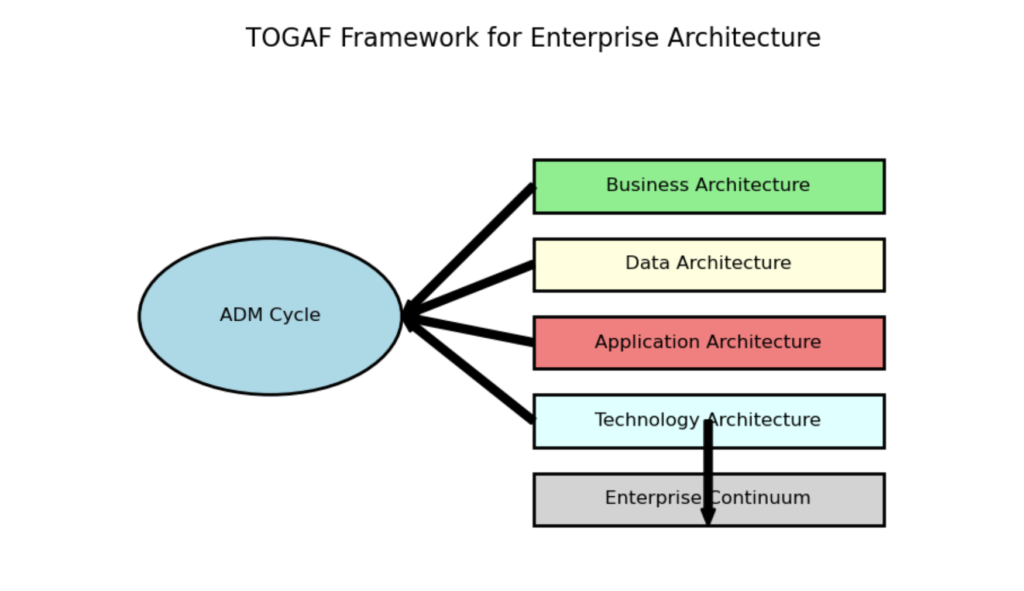
✅ Real-World Example
Imagine a national education board planning a digital transformation:
- The ADM cycle guides the process from defining the vision to deploying new systems.
- The Business Architecture defines goals like improving student access and digital learning.
- The Data Architecture structures student records, performance metrics, and learning content.
- The Application Architecture includes learning management systems and mobile apps.
- The Technology Architecture covers cloud infrastructure, security, and device management.
- The Enterprise Continuum helps reuse proven models and adapt them to the education sector.
📝 Summary
The TOGAF framework offers a powerful, structured approach to enterprise architecture. By combining the ADM cycle, architecture domains, and the Enterprise Continuum, TOGAF helps organizations align technology with strategy, reduce complexity, and drive innovation. Whether you’re modernizing legacy systems or launching new digital initiatives, TOGAF provides the blueprint for success.
-
The Benefits of Having an Enterprise Architecture
- Posted on: June 2, 2025
- by: Anand Pandey
- 0 Comments
In today’s fast-paced digital world, organizations face increasing pressure to innovate, scale, and adapt—without losing sight of their strategic goals. This is where Enterprise Architecture (EA), as defined by TOGAF (The Open Group Architecture Framework), becomes a powerful enabler.
🧱 What is Enterprise Architecture in TOGAF?
TOGAF defines Enterprise Architecture as a structured framework that helps organizations align their business goals with IT infrastructure, ensuring that every part of the enterprise works together efficiently and effectively.
It breaks down architecture into four key domains:
- Business Architecture
- Data Architecture
- Application Architecture
- Technology Architecture
These domains work together to provide a holistic view of the enterprise.
🌟 Key Benefits of Enterprise Architecture
Here are the core benefits of implementing enterprise architecture using TOGAF:
1. Alignment Between Business and IT
EA ensures that IT initiatives are directly aligned with business strategies, reducing miscommunication and wasted resources.
2. Improved Decision-Making
With a clear architectural roadmap, leaders can make informed decisions based on a comprehensive understanding of systems, dependencies, and impacts.
3. Enhanced Agility
EA provides a flexible foundation that allows organizations to adapt quickly to market changes, regulatory shifts, or new technologies.
4. Reduced Complexity
By standardizing processes and systems, EA simplifies the IT landscape, making it easier to manage, scale, and secure.
🖼 Visualizing the Benefits
Here’s a visual diagram that illustrates how these benefits flow from a well-structured enterprise architecture:

✅ Real-World Example
Consider a multinational retail company undergoing digital transformation. By adopting TOGAF:
- The business team defines goals like improving customer experience and expanding into new markets.
- The IT team uses EA to align infrastructure, applications, and data strategies with those goals.
- As a result, the company launches a unified e-commerce platform faster, with fewer integration issues and better scalability.
📝 Summary
Enterprise Architecture, when implemented through TOGAF, offers a structured approach to aligning business and IT. It empowers organizations to make smarter decisions, respond faster to change, and reduce operational complexity. In a world where agility and clarity are key, EA is not just a technical tool—it’s a strategic advantage.
Tag